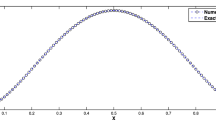Abstract
We present a review of the semi-Lagrangian method for advection-diffusion and incompressible Navier-Stokes equations discretized with high-order methods. In particular, we compare the strong form where the departure points are computed directly via backwards integration with the auxiliary form where an auxiliary advection equation is solved instead; the latter is also referred to as Operator Integration Factor Splitting (OIFS) scheme. For intermediate size of time steps the auxiliary form is preferrable but for large time steps only the strong form is stable.
Similar content being viewed by others
References
Loft, R. D., Thomas, S. J., and Dennis, J. M. (2001). Terascale spectral element dynamical core for atmospheric general circulation models. InProceedings of Supercomuting 2001, Denver.
Maday, Y., Patera, A. T., and Ronquist, E. M. (1990). An operator-integration-factor splitting method for time-dependent problems: Application to incompressible fluid flow.J. Sci. Comp. 4, 263–292.
Xiu, D., and Karniadakis, G. E. (2001). A semi-Lagrangian high-order method for Navier-Stokes equations.J. Comp. Phys. 172, 658.
Robert, A. (1981). A stable numerical integration scheme for the primitive meteorological equations.Atmos. Ocean 19, 35.
Pironneau, O. (1982). On the transport-diffusion algorithm and its applications to the Navier-Stokes equations.Numer. Math. 38, 309.
Giraldo, F. X. (2003). Strong and weak Lagrange-Galerkin spectral element methods for shallow water equations.Comput. Math. Appl. 45, 97–121.
Karniadakis, G. E., and Orszag, S. A. (1993). Nodes, modes, and flow codes.Phys. Today 34.
Karniadakis, G. E., and Sherwin, S. J. (1999).Spectral/hpElement Methods for CFD, Oxford University Press, London.
Falcone, M., and Ferretti, R. (1998). Convergence analysis for a class of high-order semi-Lagrangian advection schemes.SIAM J. Numer. Anal. 35, 909.
Huffenus, J. P., and Khaletzky, D. (1984). A finite element method to solve the Navier-Stokes equations using the method of characteristics.Int. J. Numer. Methods Fluids 4, 247.
Malevsky, A. V., and Thomas, S. J. (1997). Parallel algorithms for semi-Lagrangian advection.Int. J. Numer. Methods Fluids 25, 455.
Oliveira, A., and Baptista, A. M. (1995). A comparison of integration and interpolation Eulerian-Lagrangian methods.Int. J. Numer. Methods Fluids 21, 183.
Staniforth, A., and Cote, J. (1991). Semi-Lagrangian integration schemes for atmospheric models — a review.Mon. Wea. Rev. 119, 2206.
Malevsky, A. V. (1996). Spline-characteristic method for simulation of convective turbulence.J. Comput. Phys. 123, 466.
Bartello, P., and Thomas, S. J. (1996). The cost-effectiveness of semi-Lagrangian advection.Mon. Wea. Rev. 124, 2883.
Giraldo, F. X. (1998). The Lagrange-Galerkin spectral element method on unstructured quadrilateral grids.J. Comput. Phys. 147, 114.
McGregor, J. L. (1993). Economical determination of departure points for semi-Lagrangian models.Mon. Wea. Rev. 121, 221.
McDonald, A., and Bates, J. R. (1987). Improving the estimate of the departure point position in a two-time level semi-Lagrangian and semi-implicit scheme.Mon. Wea. Rev. 115, 737.
McDonald, A. (1984). Accuracy of multi-upstream, semi-Lagrangian advective schemes.Mon. Wea. rev. 112, 1267.
Suli, E. S. (1988). Convergence and nonlinear stability of the Lagrange-Galerkin method for the Navier-Stokes equations.Numer. Math. 53, 459.
Allievi, A., and Bermejo, R. (2000). Finite element modified method of characteristics for the Navier-Stokes equations.Int. J. Numer. Methods Fluids 32, 439.
Priestley, A. (1994). Exact projections and the Lagrange-Galerkin method: A realistic alternative to quadrature.J. Comput. Phys. 112, 316.
Achdou, Y., and Guermond, J. L. (2000). Convergence analysis of a finite element projection/Lagrange-Galerkin method for the incompressible Navier-Stokes equations.SIAM J. Numer. Anal. 37, 799.
Deville, M. O., Fischer, P. F., and Mund, E. H. (2002).High-Order Methods for Incompressible Fluid Flow. Cambridge University Press.
Momeni-Masuleh, S. H. (2001).Spectral Methods for the Three Field Formulation of Incompressible Fluid Flow. PhD thesis, Aberystwyth.
Sherwin, S. J. (2003). A substepping Navier-Stokes splitting scheme for spectral/hp element discretisations. In Matuson, T., Ecer, A., Periaux, J., Satufka, N., and Fox, P. (eds.),Parallel Computational Fluid Dynamics: New Frontiers Multi-Disciplinary Applications, North-Holland, pp. 43–52.
Leriche, E., and Labrosse, G. (2000). High-order direct Stokes solvers with or without temporal splitting: numerical investigations of their comparative properties.SIAM J. Sci. Comput. 22(4), 1386.
Ghia, U., Ghia, K. N., and Shin, C. T. (1982). High-Re solutions for the incompressible flow using the Navier-Stokes equations and a multigrid method.J. Comput. Phys. 48, 387.
Koseff, J. R., and Street, R. L. (1984). The lid-driven cavity flow: a synthesis of qualitative and quantitative observations.ASME J. Fluids Eng. 106, 390.
Xu, J., Xiu, D., and Karniadakis, G. E. (2002). A semi-Lagrangian method for turbulence simulations using mixed spectral discretizations.J. Sci. Comput. 17, 585.
Smolarkiewicz, P. K., and Pudykiewicz, J. (1992). A class of semi-Lagrangian approximations for fluids.J. Atmo. Sci. 49, 2082.
Author information
Authors and Affiliations
Rights and permissions
About this article
Cite this article
Xiu, D., Sherwin, S.J., Dong, S. et al. Strong and auxiliary forms of the semi-Lagrangian method for incompressible flows. J Sci Comput 25, 323–346 (2005). https://doi.org/10.1007/BF02728994
Received:
Accepted:
Issue Date:
DOI: https://doi.org/10.1007/BF02728994




